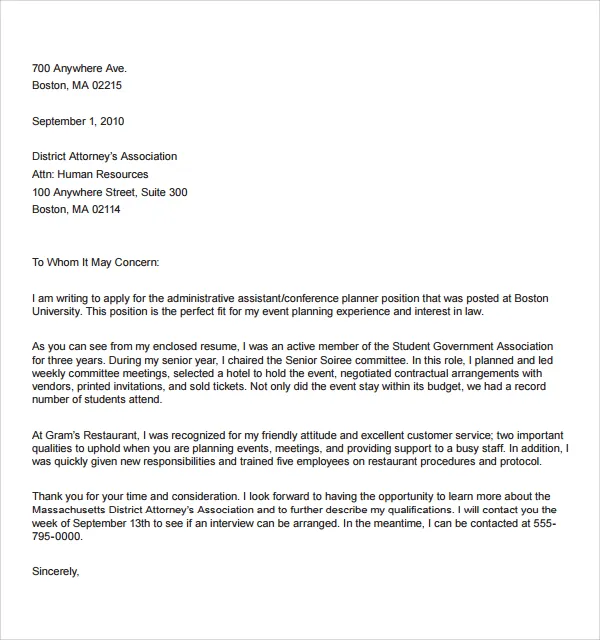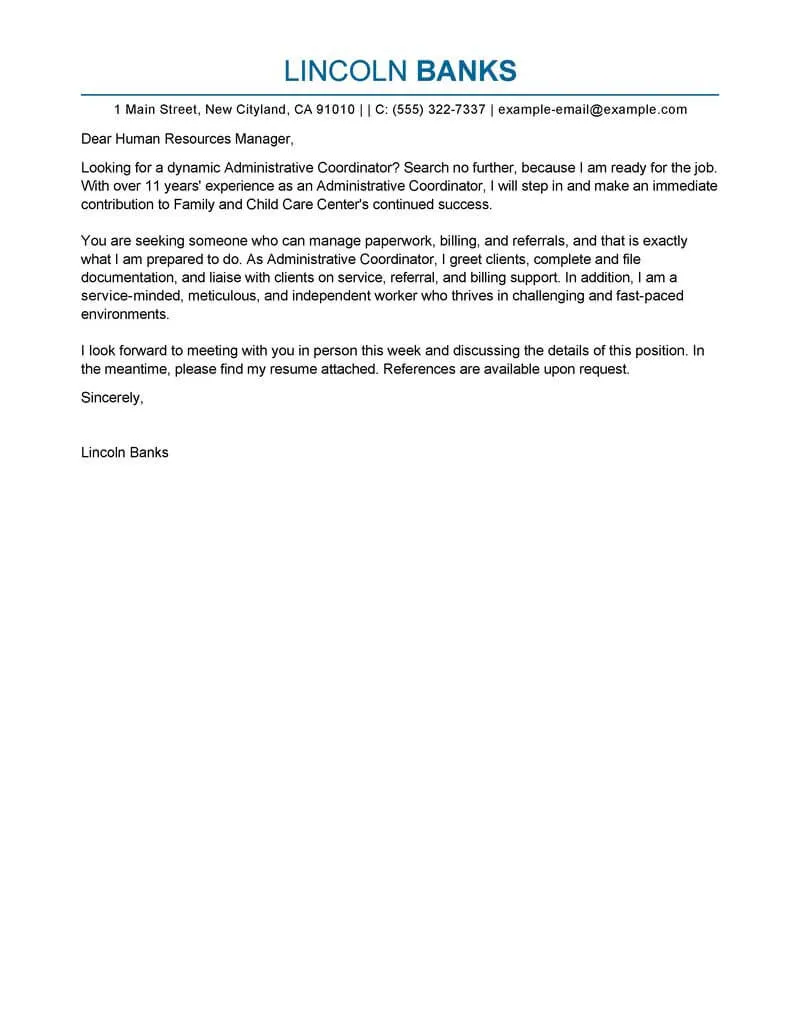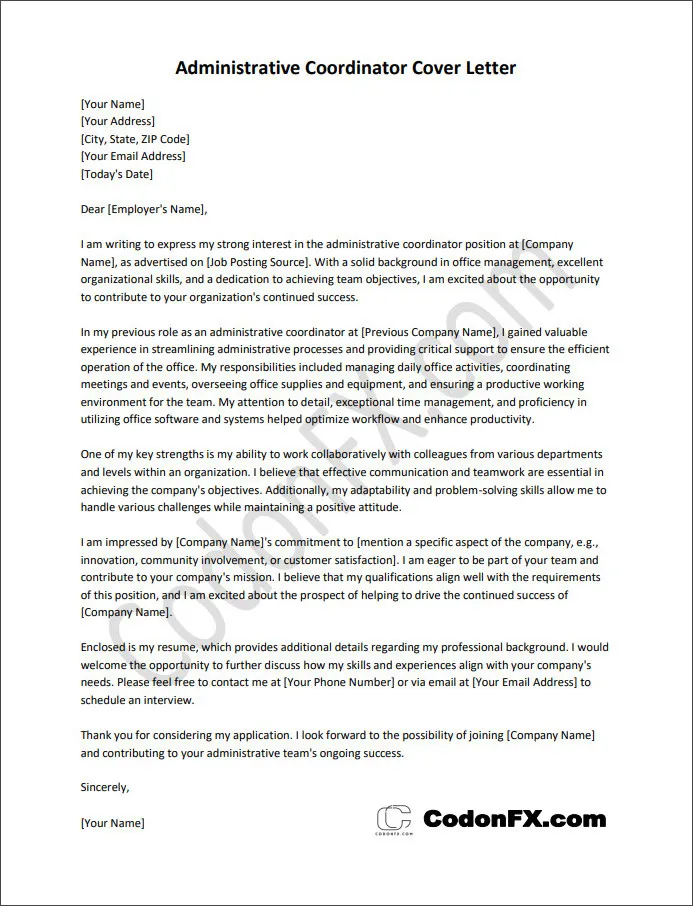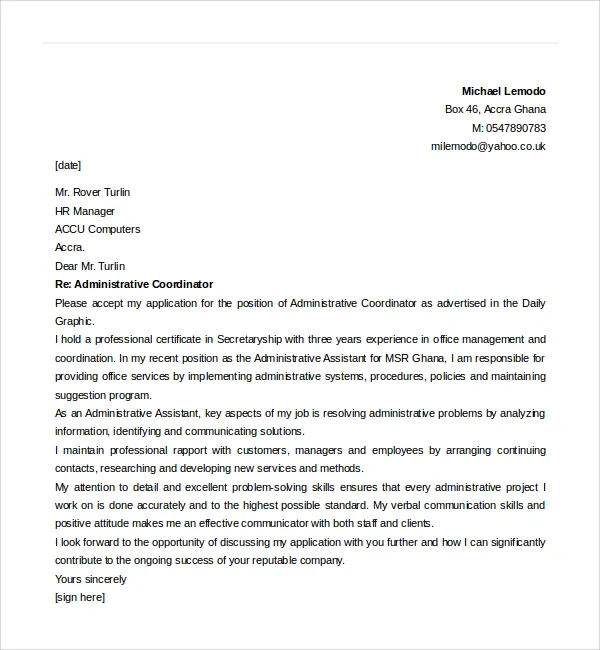Crafting Your Administrative Coordinator Cover Letter
An administrative coordinator cover letter is more than just a formality; it’s your first opportunity to make a lasting impression on a potential employer. It serves as a personal introduction, a chance to showcase your skills, and an invitation to an interview. A well-crafted cover letter complements your resume, providing context and depth to your qualifications. This guide will walk you through the essential steps of writing a compelling administrative coordinator cover letter that will help you stand out from the competition. Remember, each cover letter should be tailored to the specific job and company you’re applying for to maximize your chances of success. Avoid generic templates and instead, personalize your letter to reflect your unique qualifications and understanding of the role.
Essential Elements of an Effective Cover Letter
Before diving into the specifics, it’s important to understand the fundamental components that make up a strong cover letter. A compelling cover letter comprises several key elements, each playing a crucial role in presenting you as a qualified candidate. These include your contact information, a formal salutation, an engaging opening paragraph, a detailed section highlighting your skills and experience, a demonstration of your enthusiasm for the role, and a professional closing. Each section must be carefully written and relevant to the specific job requirements. Ensure your letter is free of grammatical errors, uses a professional tone, and is easy to read. Adhering to these guidelines will increase your chances of capturing the employer’s attention and securing an interview.
Contact Information and Date

Start your cover letter by providing your contact information at the top. This typically includes your full name, address, phone number, and email address. Ensure that your email address is professional. Directly below your contact information, add the date. Following this, include the recipient’s contact information, which comprises the hiring manager’s name, title, the company name, and the company address. This structured approach immediately establishes professionalism and makes it easy for the employer to contact you. Always double-check the accuracy of the information to prevent any communication issues.
The Salutation
The salutation sets the tone for the entire letter. Always address the hiring manager by name if possible. Research the company’s website or use LinkedIn to find the name of the hiring manager. If you are unable to find a specific name, use a professional alternative like “Dear Hiring Manager.” Avoid generic greetings such as “To Whom It May Concern.” Using a specific name shows that you have done your research and are genuinely interested in the position. This personal touch can make your cover letter stand out. The salutation must be followed by a colon or a comma, but be consistent throughout.
Opening Paragraph
The opening paragraph is your chance to grab the reader’s attention. Start by stating the specific position you’re applying for and where you saw the job posting. Briefly mention why you are interested in the role and the company. Highlight a key skill or experience that aligns with the job requirements. This opening should be concise, enthusiastic, and demonstrate your understanding of the company’s needs. Avoid generic openings. Instead, show your personality and express genuine interest. Keep it brief, focusing on immediately capturing the reader’s interest.
Highlighting Your Skills and Experience

This is the core of your cover letter, where you showcase your qualifications. The body of your letter must detail how your skills and experiences align with the job requirements. Divide this section into smaller paragraphs, each addressing a specific skill or experience. Provide concrete examples of how you have used these skills in previous roles, and mention the results you achieved. The goal is to demonstrate your ability to perform the job effectively. Use keywords from the job description to tailor your cover letter to the specific needs of the employer. This is not just a summary of your resume; it’s about making a case for your suitability for the role.
Demonstrating Relevant Skills
Identify the key skills that the job description highlights. Examples include organizational skills, communication skills, proficiency in specific software (e.g., Microsoft Office, CRM systems), and problem-solving abilities. For each skill, provide a specific example from your past experience that demonstrates your proficiency. For instance, if the job requires strong organizational skills, describe a time when you successfully managed multiple projects simultaneously, or if it requires excellent communication skills, describe a situation where you effectively communicated complex information to a diverse audience. Quantify your accomplishments whenever possible to make your claims more credible.
Showcasing Achievements
Focus on your achievements rather than just listing your responsibilities. Highlight what you accomplished in previous roles. Use the STAR method (Situation, Task, Action, Result) to structure your examples. Start by describing the situation, then the task you were assigned, the action you took, and the result of your actions. For example, describe how you improved office efficiency, reduced costs, or streamlined processes. Make sure your achievements are relevant to the job you are applying for. This approach makes your cover letter more compelling and demonstrates the value you can bring to the new role.
Quantifying Your Accomplishments

Whenever possible, quantify your accomplishments. This makes your achievements more concrete and impactful. Instead of saying “Improved office organization,” say “Improved office organization by implementing a new filing system, resulting in a 20% reduction in time spent searching for documents.” Instead of writing “Managed projects,” write “Managed projects with budgets up to $50,000, consistently delivering them under budget and ahead of schedule.” Quantifiable data adds credibility to your claims and allows the employer to understand the tangible benefits you can provide.
Expressing Enthusiasm for the Role and Company
Expressing your enthusiasm for the role and the company is crucial. Explain why you are excited about the specific opportunity. Mention something that you admire about the company, whether it’s their mission, their values, or their products. Show that you have researched the company and understand their culture and goals. Tailor your cover letter to demonstrate how your skills and experience align with the company’s needs and how you can contribute to its success. This personal touch shows you are genuinely interested in the opportunity and not just sending out a generic application.
Closing the Cover Letter
Your closing should reinforce your interest in the position and call the reader to action. Briefly reiterate your key qualifications and express your enthusiasm for the opportunity. Make it clear that you are eager to discuss your qualifications further and that you are available for an interview. Always thank the hiring manager for their time and consideration. This closing paragraph leaves a positive final impression and reinforces your commitment to the role.
Formal Closing and Signature

Use a professional closing such as “Sincerely,” or “Best regards.” Avoid informal closings. Leave space for your signature if you are submitting a physical copy. If you are submitting an electronic version, you may simply type your full name below the closing. Ensure that your name is clearly visible. This formal closing adds to the professionalism of your cover letter.
Proofreading and Editing
Before submitting your cover letter, proofread it carefully. Check for any grammatical errors, spelling mistakes, and typos. Ensure that the formatting is consistent and professional. It is also a good idea to have someone else review your cover letter for clarity and accuracy. A polished cover letter reflects your attention to detail and professionalism. Pay close attention to every word and ensure it accurately represents you and your qualifications. Poorly written cover letters can damage your chances of landing an interview.
